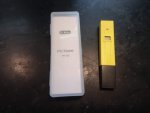- Oct 25, 2015
- 5,125
- Pool Size
- 25000
- Surface
- Plaster
- Chlorine
- Salt Water Generator
- SWG Type
- CircuPool RJ-60 Plus
Folks,
Many of you may recall I have a fairly common (in men) color blindness that affects my ability to discern shades of red so I use a digital pocket tester for pH instead of the red/orange ph color drop test. I've been doing this a couple of years now and have some things I've learned to pass along:
I hope this helps.
Chris
Many of you may recall I have a fairly common (in men) color blindness that affects my ability to discern shades of red so I use a digital pocket tester for pH instead of the red/orange ph color drop test. I've been doing this a couple of years now and have some things I've learned to pass along:
- Batteries last about one year of 3 times/week testing.
- When readings get erratic or seem to be drifting upward you probably need new batteries or to make sure there's no corrosion on the contacts.
- Calibrate monthly with standard solution you can buy online under $10. Buy a smaller bottle as it will last you longer than it's shelf life.
- After calibration rinse the electrodes thoroughly in the tap and be careful not to get water above the electrodes on the end.
- I put the cap on wet (don't shake it off). Better life will be achieved if you put a sponge soaked with KCl storage solution. You can buy this on Amazon also around $10.
- Be sure to turn it off after use, it can run down the battery much quicker if you forget.
- These all seem to be made by the same couple of manufacturers, be sure to get ATC (automatic temp calibration). Even with this feature they are only around $15. So far mine is over 2 years old and still going fine.
- Make sure you let the meter fully stabilize... it may look like the reading has stopped changing but wait a minute or two. It often can change another .5 pH unit.
- After use, rinse the tip with tap water (never distilled water) and store it wet with the cap firmly.
- Never allow the tip to dry out! The cap fits tightly to ensure less evaporation.
I hope this helps.
Chris
Last edited:


